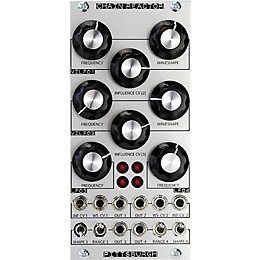DigitalPianistSynths
Guitars
Guitars
Amps & Effects
Amps & Effects
Used & Vintage
Keyboards & MIDI
Keyboards & MIDI
Drums
Drums
DJ Equipment
DJ Equipment
Basses
Basses
Recording
Recording
Live Sound
Live Sound
Accessories
Accessories
Mics & Wireless
Mics & Wireless
Music Software
Music Software
Lighting
Lighting
- Popular Brands
Band & Orchestra
Band & Orchestra
Platinum Gear
Platinum Gear
Deals
Pittsburgh Modular Synthesizers Chain Reactor Module
$279.00
Order it today! This item is backordered, but you can save your place now so you don’t miss it when it’s back in stock. You won’t be charged until it ships.
Notify me when this item is in stock.
6-month special financing^ + $13 back in Rewards** Limited time Learn More
Lease-To-Own Purchase OptionsLearn more
Protect your gearLearn more
Cover drops, spills or cracks with Pro Coverage
Need Help?

 Description
Description
The Chain Reactor combines two of our classic VILFO modules with two additional free running LFOs to create an endless supply of chaotic fluctuations. VILFO1 and VILFO2 feature our unique voltage influence control. Voltage influence works differently than standard voltage control, it allows the incoming CV to mingle with the LFO waveforms in interesting ways, creating unique modulations and patterns. The output of each VILFO is a voltage controlled variable waveform that shifts from a triangle to square wave.
The Voltage Influence Circuit
A typical Voltage controlled oscillator works by using a CV input to directly control the oscillation frequency. The more voltage sent to the CV input, the higher the frequency of the oscillator. The lower the voltage, the lower the frequency of the oscillator. Voltage Influence works by using the CV input to attenuate the frequency of the oscillator while at the same time injecting some of the voltage from influence CV input to the feedback loop of the oscillator. Results can vary from subtle to chaotic. Subtle results can be similar to tremolo, shuffle, or soft reset while more extreme settings produce glitchy, rhythmic, chaotic fluctuations in the frequency of the oscillator.
A Chain Reaction
Three of the modulation sources within the Chain Reactor are patched together using switched jacks to ceate complex modulations without needing to use patch cables. The output of LFO3 is patched to the influence CV input of VILFO2 and the output of VILFO2 is internally patched to the influence CV input of VILFO1. The fourth LFO is not prepatched but can be used to modulate the waveshape of VILFO1 or VILFO2. The internal routing between modulation sources within the Chain Reactor can be defeated by patching an external CV souce into the module.
The Voltage Influence Circuit
A typical Voltage controlled oscillator works by using a CV input to directly control the oscillation frequency. The more voltage sent to the CV input, the higher the frequency of the oscillator. The lower the voltage, the lower the frequency of the oscillator. Voltage Influence works by using the CV input to attenuate the frequency of the oscillator while at the same time injecting some of the voltage from influence CV input to the feedback loop of the oscillator. Results can vary from subtle to chaotic. Subtle results can be similar to tremolo, shuffle, or soft reset while more extreme settings produce glitchy, rhythmic, chaotic fluctuations in the frequency of the oscillator.
A Chain Reaction
Three of the modulation sources within the Chain Reactor are patched together using switched jacks to ceate complex modulations without needing to use patch cables. The output of LFO3 is patched to the influence CV input of VILFO2 and the output of VILFO2 is internally patched to the influence CV input of VILFO1. The fourth LFO is not prepatched but can be used to modulate the waveshape of VILFO1 or VILFO2. The internal routing between modulation sources within the Chain Reactor can be defeated by patching an external CV souce into the module.

Featured Articles
 Reviews
Reviews
Be the first to review the Product
 Q&A
Q&A
Have a question about this product? Our expert Gear Advisers have the answers.
No results but…
You can be the first to ask a new question.
It may be Answered within 48 hours.



